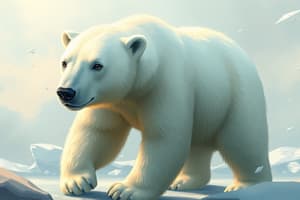Podcast
Questions and Answers
What adaptation helps Siberian tigers blend in with snowy environments?
What adaptation helps Siberian tigers blend in with snowy environments?
- Shorter tails
- Bright orange fur
- Longer claws
- Paler stripes (correct)
Arctic woolly bear mammoths can freeze themselves for survival during winter.
Arctic woolly bear mammoths can freeze themselves for survival during winter.
True (A)
What effect does melting permafrost have on the environment?
What effect does melting permafrost have on the environment?
It releases methane and other harmful substances.
Cushion plants trap dust from the air in their leaves to gain ______.
Cushion plants trap dust from the air in their leaves to gain ______.
Match the follows adaptations with their corresponding species:
Match the follows adaptations with their corresponding species:
What is one method proposed to manage permafrost?
What is one method proposed to manage permafrost?
Areas near the poles receive concentrated heat from the sun.
Areas near the poles receive concentrated heat from the sun.
What happens to the air around the North and South Pole?
What happens to the air around the North and South Pole?
Flashcards
Cold Desert
Cold Desert
A type of desert found in polar regions characterized by extremely low temperatures, low precipitation, and permafrost.
Blubber
Blubber
A thick layer of fat that helps animals stay warm in cold environments.
Rewilding
Rewilding
The process of restoring an ecosystem to a healthier state, often by reintroducing native species.
Permafrost
Permafrost
Signup and view all the flashcards
Climate Change
Climate Change
Signup and view all the flashcards
Methane
Methane
Signup and view all the flashcards
Albedo
Albedo
Signup and view all the flashcards
Painting Roads White
Painting Roads White
Signup and view all the flashcards
Study Notes
Cold Deserts
- Found north of the Arctic Circle and south of the Antarctic Circle.
- Characterized by low precipitation and cold temperatures.
Siberian Tiger Adaptations
- Thick fur: Provides insulation against cold.
- Belly blubber: Additional insulation and protection.
- Paler stripes: Camouflage in snowy environments.
- Excellent vision: Crucial for hunting in both day and night.
Arctic Woolly Bear Mammoths (Caterpillars)
- Extremely active in summer for food storage.
- Resistance to freezing allows them to endure winter.
- Freeze over the winter.
Cushion Plants
- Grow close to the ground for wind protection.
- Collect dust for nutrients.
Arctic Poppies
- Have hairy stems for heat retention.
- Orientate with the sun to maximize energy absorption.
Climate of Polar Regions
- Less concentrated solar heat due to Earth's curvature.
- Dry air.
- High-pressure zone, causing sinking air and minimal precipitation.
Permafrost Melting in Siberia
- Caused by rising temperatures due to climate change.
- Has both positive and negative effects.
Positive Effects
- Unearthing fossils.
Negative Effects
- Release of methane and harmful substances.
Permafrost Management Strategies
Rewilding
- Introduce large mammals.
- Reduce plant cover to increase heat reflection.
- This method is proven in small areas but needs a large number of animals to be effective.
Painting Roads White
- Reflects heat and prevents permafrost melt.
- This method is utilized in other permafrost areas but requires considerable financial investment.
Studying That Suits You
Use AI to generate personalized quizzes and flashcards to suit your learning preferences.




